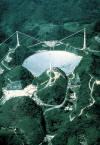Life on Earth
- In the beginning, the Earth was not life-friendly:
- Very high volcanic activity, with lots of outgassing.
- The atmosphere was composed primarily of CH4, NH3,
H2, and H2O.
- No oxygen, ozone—high UV radiation.
- Lots of collisions, which dropped off dramatically after about 800
million years.
- This early period of so-called heavy bombardment included the
massive collion with a Mars-sized object which ultimately produced our
Moon.
- The oldest fossils are from cyanobacteria, dated to roughly 3.5 billion
years ago, shortly after the period of heavy bombardment.


Landmarks in our understanding of life
- Before the 1600’s, the notion that life can form from non-living matter was
an accepted idea. People believed that:
- open wounds produce maggots
- garbage produces mice
- rotting meat produces flies
- sweat produce fleas and mice
- mud produces frogs and snakes
- rotting logs at the bottom of rivers produce crocodiles
- In 1668, Francesco Redi (1626–1697), an Italian physician, established that
rotten meat does not produce flies; only flies
produce flies. The experiment is regarded as one of the first steps in
refuting "spontaneous generation" -- a theory also known as Aristotelian
abiogenesis.
- In the 1800's, Louis Pasteur debunked the widely accepted myth of
spontaneous generation for microbes, thereby setting the stage for modern biology and
biochemistry.
- In 1953, Stanley Miller, a graduate student
working the laboratory of Harold Urey, built an
apparatus to demonstrate that biological
molecules, on which all life is based, can result under the conditions of
primeval Earth. After mixing methane, ammonia, water, and a spark, Miller
produced a variety of bio-organic compounds, including amino acids, nucleic
acids, and ATP.
- In 1969, the
Murchison meteorite that fell near
Murchison, Victoria,
Australia
was found to contain over 90 different amino acids, nineteen of which are
found in Earth life. This fueled the notion that life here on Earth may have
been originated from the complex organic molecules (as well as water)
brought here by space debris. This could also imply an origin of life
outside of Earth, which then migrated here (see
Panspermia).






Drake equation
- In 1961, astronomer Frank Drake proposed
his famous
equation for the probability of intelligent life in the Universe.
- The Drake equation attempts to answer the grand question of the number
of communicating civilizations in our galaxy by considering simpler
questions which are more easily quantifiable.
- While most of the factors in the Drake equation can be somewhat
quantified, the factor which suffers from the greatest uncertainty is the
longevity of an advanced civilization. Clearly, we have only one data
point--us--and even that does not tell us how long our civilization will
persist.
- Because of the uncertainty in the various factors in the Drake equation,
particularly the longevity factor, the Drake equation cannot currently tell
us how many advanced civilizations are out there. However, the Drake
equation remains a reasonable starting point for discussion.
- You can play around with this
estimator and come up with your own estimate.
- Fermi’s paradox: If extraterrestrial intelligent life
is common, it is very
likely that this life would have colonized much of our Galaxy (and Universe)
by now, after billions of years of cosmic evolution. So where are they?
There are several possible responses, although the last one is favored by most astrobiologists:
- We have not made contact because civilizations do not leave
their home worlds—either because they are uninterested in interstellar
travel or because they destroy themselves before achieving it.
- There are galactic civilizations out there, but they have deliberately avoided
revealing their existence to us.
- We have not made contact because advanced civilizations are not
common.
- This
Kurzgesagt video discusses these issues in a lively and (literally)
animated way.
- The Rare
Earth Hypothesis argues that complex (or intelligent) life is not common
in the Universe, though the Universe might well be teeming with primitive
life forms, such as bacteria.


SETI
- A project now known as the Search for
Extraterrestrial Intelligence (SETI) was begun back in the 1960s to search
the heavens for radio signals that reach us from some other technological
civilization in the Cosmos.
- NASA funded the program in the 1980s but Congress pulled the plug on the
project in the early 1990s. They sought private funding for their research
and have now established the SETI
institute.
- SETI's Arecibo radio-telescope in Puerto Rico,
the largest Earth-based telescope in the world, is continuously scanning the
sky in search of some signal that would stand out as being unequivocally
unnatural. They do this with supercomputers and a network of radio
telescopes around the world.
- Radio communication is simple, inexpensive, and the Universe is
relatively quiet at most radio frequencies. So it is not unreasonable to
suppose that the first choice for an alien civilization to attempt to make
contact would be via radio communication.
- Proposals for interstellar languages have taken many forms, with two
major strands focusing on either pictorial messages or logic-based messages.
Presumably, an advanced civilization would discover the same laws of nature
that Earthlings have. The
Arecibo message
is a good example of how simple math can be converted into a relatively
sophisticated message about our location, size, DNA, etc.
- The UC Berkeley SETI team has discovered a way to tap the unused CPU
power of idle home computers through a screen
saver that analyzes bits of SETI's data and makes you a part of the
greatest supercomputer on Earth. Over 2 million people in over 200 countries
have now joined SETI@home (also known as project SERENDIP).
- Currently, astronomers use radio waves in the narrow frequency band
(1420-1640 MHz) corresponding to a wavelength band (18-21 cm) to search for
extraterrestrial signals. This band is known as the
water hole.
- This is the band between the hydrogen spectral line and the strongest
hydroxyl spectral line. The combination of hydrogen and hydroxyl yields
water (the "water" part of the name); the "hole" part refers to the sudden
drop in radio noise within this band.
- The water hole is also a quiet region bounded by galactic noise on the
low-frequency end and by atmospheric nose on the high-frequency end.
- Since the H and OH lines are visible from anywhere in the cosmos, in the
quietest part of the spectrum, one might argue that these markers are not
necessarily geocentric.
- Scientists hypothesize that the water hole would be a good communication
channel with extraterrestrial species because water is currently considered
the universal prerequisite for life. Consequently, H and OH lines constitute obvious
signposts to a natural interstellar communications band, one which would
likely occur to other water-based life forms who have some knowledge of the
radio sky.
- In English vernacular, a watering hole is a reference to a common place
to meet and talk.
- The term 'water hole' was coined by SETI pioneer
Bernard Oliver.
"Where shall we meet our neighbors?" he asked. "At the water-hole, where
species have always gathered."
- So far there have been no detections. But the search continues.



Habitable Zone
- Broadly speaking, there are three ingredients upon which life depends:
water, energy, and organic molecules. The region where conditions might
potentially support life is called the Habitable Zone.
- There are actually two types of habitable zone: galactic (GHZ) and
circumstellar (CHZ).
- The circumstellar habitable zone (CHZ), also known as the Goldilocks
Zone, is generally defined as the region around a star where water could
exist on the surface of an Earth-like planet.
- The CHZ depends on the mass
of the parent star. The more massive (or luminous) the star, the farther and wider the
habitable zone since the dependence of temperature on distance is not as
steep at greater distances from the star.
- In our own solar system, the CHZ is thought to
lie within the band 0.95-1.37 AU's (from the Sun).
- As our Sun ages and becomes more luminous, the CHZ will drift
outward and will reach Mars in about a billion years.
- The galactic habitable zone (GHZ) is characterized by the following:
- It is an annular region of our Galaxy in which, according to
hypothesis, conditions are best suited to the development and survival
of life as we know it. Outside the galactic habitable zone (GHZ) various
factors make the existence of complex (multicellular) life difficult, if
not impossible.
- It is sufficiently close to the center of the Galaxy to have a high
level of heavy elements, such as carbon, to favor the formation of rocky
planets and complex molecules of life. The outer fringe of the galaxy is
a difficult place to build life-supporting planets because there are
fewer heavy elements.
- It is sufficiently far from the galactic center to avoid threats to
complex life: nearby transient sources of ionizing radiation, including
supernovae and gamma ray bursters, impacts with space debris, close
encounters with passing stars. Presumably, large amounts of radiation,
which occur near the center of a galaxy, make formation of complex
molecules more difficult.
- The current GHZ is said to extend 7-9 kiloparsecs (23,000-29,000
light-years) from the galactic center, is widening with time, and is
composed of stars that formed 4-8 billion years ago. The GHZ is
analogous to the much more well established concept of the circumstellar
habitable zone (CHZ).

Rare Earth Hypothesis
- The Rare Earth hypothesis argues that the emergence of complex life
required a host of fortuitous circumstances, the seemingly rare combination of which
suggests that intelligent life may be uncommon in the universe.
- Our relatively large Moon exerts a stronger tidal force on Earth that
does the Sun and protects us from being tidally locked to the Sun.
- The Earth has a relatively strong magnetosphere that protects us from
harmful radiation.
- The Earth has the right combination of size and composition to have
plate tectonics, which helps to replenish the atmosphere (some of which
constantly escapes into space).
- Jupiter protects us from (reduces the chance of) impacts with comets and
asteroids.
- Massive stars may not live long enough to allow biological evolution to
produce intelligent critters.
- Smaller stars have habitable zones which are relatively close and
narrow. The closeness implies tidal hyperactivity and tidal locking.
- The term "Rare Earth" comes from Rare Earth: Why Complex Life Is
Uncommon in the Universe (2000), a book by
Peter Ward, a geologist and paleontologist, and Donald Brownlee, an
astronomer and astrobiologist.

